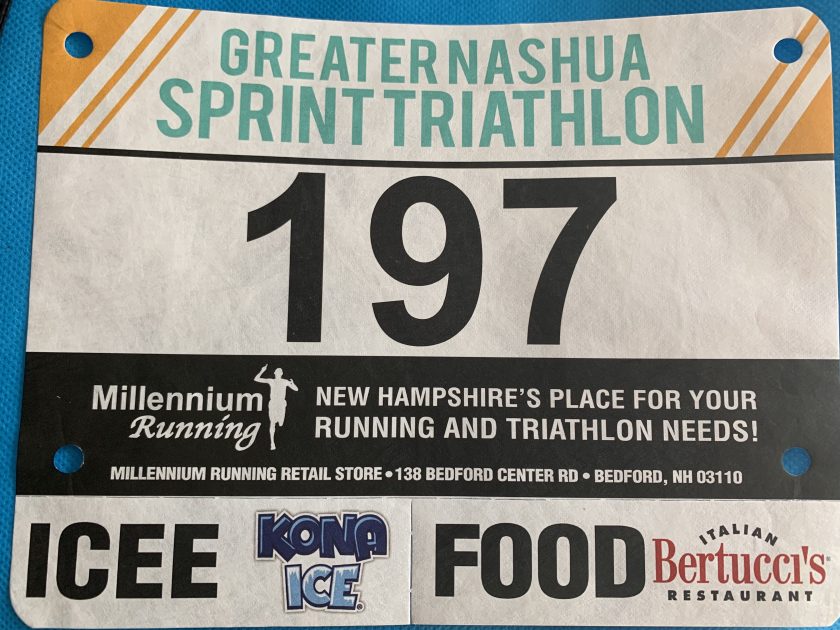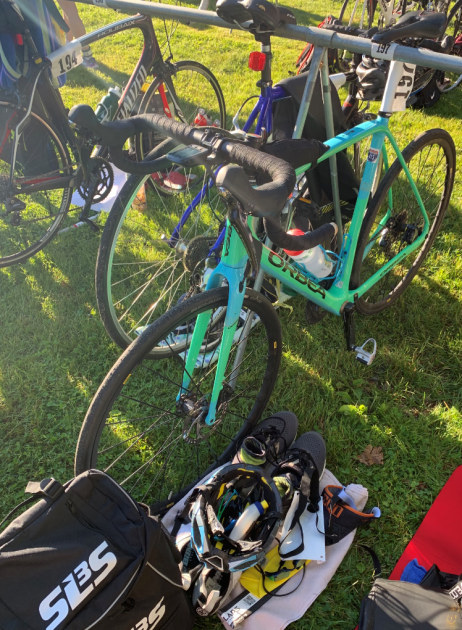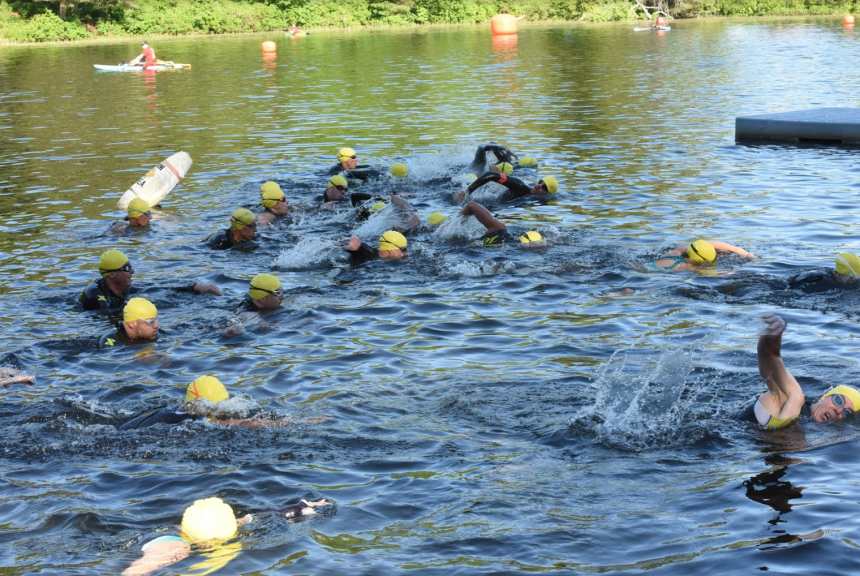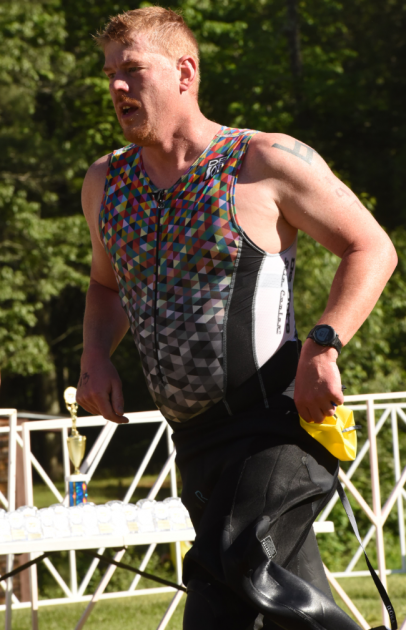
My first triathlon of 2019 was a sprint distance race held in southern New Hampshire, called the Greater Nashua Sprint Triathlon. I settled on this race in particular after several months of research, trying to find a race that was both within driving distance and lined up with my training schedule for my 70.3 race. I didn’t know anything about it other than what I found on the website and Facebook page, but it was the 10th annual running of the event, so it seemed likely to be a well-organized race.
Pre-Race
An added bonus to this race was that my wife’s parents and brother live just an hour away from the race location, so we were all able to stay with them and combine it into a family visit. It’s a huge benefit to race day preparations to be in a comfortable location with family before an event, so I’m grateful we were able to have that opportunity. I went to bed at the same time as my kids, and actually managed to sleep through most of the night. I only woke up once, at about 3 AM, and then drifted in and out until about 5, when I got up.
Breakfast was my customary bowl of oatmeal flavored with maple syrup with a coffee. While I had the syrup out, I took the opportunity to fill my gel bottle. I still wasn’t sure if I would even use fuel during the race, because it was so short, but I figured it couldn’t hurt to have it along.



I had everything pretty much ready to go the night before, so all I had to do in the morning was load my bike, put my transition bag in the car, and head out. The drive was uneventful. As I got close to Nashua, I started to see more and more cars carrying bikes. It wasn’t long before I saw a fully decked out Quintana Roo on the back of a pickup. Welcome to New Hampshire.
Parking was an absolute nightmare. There was a lot designated for racers, which was the entire area around a local school, but it was already packed to the gills by the time I arrived. I ended up having to park underneath a swing set. I checked the air in my tires at my car, put my transition bag on my bag and rode to the transition area.
Transition was pretty well organized, with everyone having a marked spot on the racks. Once again my bike was too tall to fit very well on the rack. The saddle was too high to easily get it under the bar, and then there wasn’t enough of a hang to keep it on there securely. Not much I could do about it, so I set up my transition stuff and went to get body-marked, check out the transition routes, and wander down to the water.

There were about 15 minutes of announcements before the race, which felt like they took forever. I tried to keep my arms moving, doing some arm circles and such, but mostly just stood around feeling my springs coil. Finally, they started calling waves. Everyone had an assigned wave number, and when your wave was called, you went down to a dock area to check-in and queue up for the start.
Swim
This was my first race wearing a wetsuit. It was also my first race with a wave start. It cheated everyone out of some time, because the timing mat was on the dock and the waves treaded water for a minute or two before actually starting. But at least everyone lost the same amount of time, so it didn’t really matter.
I put some water on the back of my neck just before jumping in, but it felt like a warm bath. I was prepared for a cold shock when stepped off the dock, but it was just balmy. I grabbed the start line rope and floated until the starter gave us the go signal, then I was off.

Almost immediately, I felt like something was wrong. I wasn’t more than 30 seconds into it and I felt absolutely awful. I thought I might be getting sick. Was I even moving? I couldn’t really tell. My line was way off, too, and I kept veering to the right. I tried to focus on my technique and things got a little better. I decided that whatever I was feeling, it wasn’t getting any worse, so I would just push through it. I had done enough swim training to know that I wouldn’t suddenly drown or anything, especially while wearing a buoyant wetsuit. The worst case was that my arm strength would just give out, and it hadn’t yet. So there was no reason to stop. On I went.
About halfway through the loop, I started catching some people. I have no idea if they were in my wave or the wave before mine, or possibly the wave after mine, having gotten ahead of me at the start. I didn’t try to swim over anyone but I didn’t really seem them coming, either, so some contact was inevitable.
I hadn’t set a goal time for the swim, but from experience I expected something between 10-15 minutes in the back of my mind. When I finally stood up to exit, it felt like it had been twice that, but I figured realistically it was maybe 12 minutes.
I looked at my watch and saw an 8. Suddenly things made a little more sense. I had been going faster — much faster — than I thought. No wonder I felt like my chest was going to explode.
Official Swim Time: 8:49 (.3 mi) – 1:41/100 yd
7/32 in age group; 34/414 overall
T1
T1 sent us up a sandy path through the woods to the grassy area where the bikes were. There were wetsuit strippers waiting for us, which was awesome. I pulled my wetsuit down below my waist, slid into home on the tarp, and my suit was popped off before I even knew what was happening. I thanked the volunteers and headed to my bike.

I had toyed a bit with leaving my shoes on my bike with rubber bands, but ultimately couldn’t really figure out how to do it so it worked properly, and I was worried about the rubber bands getting caught in my gears, so I decided to just put my shoes on in transition, run the bike out, and clip in. I certainly wasn’t going to try a flying mount, so this was a reasonable option for me. At the last second I grabbed my maple syrup bottle and slid it into my tri suit pocket.
Official T1 time: 3:13 – 91/414 overall
Bike
The bike route was very short, and very flat. I’d only done three previous races before this one, but this was the shortest and flattest by far. I had been doing a lot of mental gymnastics about the bike leg in the days leading up to the race, debating my approach. Overall, I wanted this race to be something of a practice session for my 70.3 — transition logistics, using a wetsuit, etc. I thought about also extending that to pacing, to practice the mental and emotional control required to slow myself down at the start of the bike leg so that I would be able to hold the right pace throughout, and then have enough left over for the run. But as soon as I was clipped in, that decision was made. It was go time.
Because I didn’t have any pacing or power targets, I ended up watching my heart rate most of all while out on the course, followed by my speed. My heart rate was shockingly high compared to the levels I was used to seeing during my training, which is predominantly spent in zone 2. But I knew that wasn’t necessarily a problem. The race was short enough that I could work at or above threshold for the whole thing. They call it a sprint for a reason, after all.
The other fun thing about a sprint is that passing someone on the bike leg is usually permanent. In a longer race, it can often be just the first of two meetings, the second of which being when they come back and smoke you on the run. But in a sprint, they are more likely to run out of road if you go full throttle on the bike. Since it was a wave start, I knew that passing people was not an entirely accurate representation of my place in the field. But it was motivating anyway. So I reeled in as many people as I could, and made sure that nobody passed me. The best part was passing those $6,000 tri bikes on my gravel bike with regular old drop bars.
As it turned out, I was glad to have my maple syrup on board. I took a couple hits, one partway through and one just before T2. It felt helpful, and made me realize that I would probably need more fuel than I had been thinking during my longer race in July.
The bike course covered, I had a clean dismount just at the line, and ran my bike in to the transition area again.
Official Bike Time: 25:45 (9.6 mi) – 22.4/mph
4/32 in age group; 18/414 overall
T2
T2 was my slowest performance on the day, relative to the field. I didn’t deliberately go slow, but I wasn’t rushing, either. I’m pretty particular about how my shoe lace-up feels, and that combined with the socks I use (which are not super easy to get on) probably accounted for my slow time. But I made it out on the run with everything I needed and feeling pretty good, so I wasn’t too worried about blitzing through T2.
Official time: 1:51 – 313/414 overall
Run
I expected to be running fast out of transition, having experienced that phenomenon before. Adrenaline is high and you are excited to just get going, and before you know it you’re running way faster than you expected. I checked my watch after a couple hundred yards and saw I was running close to 7:30 min/mi, which is very fast for me. For reference, I ran all of my sprints last year at around 9:00 min/mi. My first reaction was to feel like I needed to back off, slow down and find a more conservative pace, but then I remembered it was only 3.1 miles. I was able to hold a strong pace through the swim and bike, why not the run? Might as well go for it, and see how long I could hold it before I slowed down. The worst case was that my pace would slow for the back half of the race, but I knew I would finish no matter what. Go time continued.
I focused on my cadence through most of the run, trying to keep the rhythm even and high. That seems to be my key to running fast (such that “fast” is, for me), when I need to. If I think about ‘running fast,’ it’s harder to do, but if I just focus on my cadence, it’s easier for some reason.
The run was also a very flat course, with only a couple slight inclines, when my pace dipped closer to 8:00 min/mi. I was able to hold my cadence pretty well throughout. Two or three people passed me, including a 60+ year old woman and a kid, wearing the race t-shirt. Sigh. But overall I held my pace and I felt strong throughout.
By the time the last half-mile came around, I was starting to feel it, particularly in my hips and my abdominals. I was definitely on the edge, pushing to maintain the pace. There wasn’t much of anything left for a late surge, all I could do was hold what I had through the chute and over the finish line.
Official Run Time: 24:19 (3.1 mi) – 7:50/mi
11/32 in age group; 65/414 overall
Overall Results:
Time: 1:03:55
5/32 in age group; 34/219 by gender; 36/414 overall
Post Race & Summary
The race venue had a lot of activities for kids, which was great for when my family arrived. There were at least three bouncy houses, plus a clown making balloon animals, and kid-friendly food. The food was great, and there was tons of it, all of it free as far as I could tell, at least for racers. It wasn’t just bananas and bagels, there was an entire sandwich buffet, flatbread pizza, Italian ice, all kinds of things. The only real negatives for me about the race organization and venue were parking and the lack of a professional race photographer (there were only official volunteers, who took substandard photos and whose coverage was incomplete). Otherwise, it was a well-organized and fun race on a decent course.
As far as my performance goes, I came away a little surprised and with a lot to think about. I had definitely underestimated my potential in the water and on the run. I really didn’t have any idea that I could swim or run that fast over any distance. Almost immediately, I started thinking ahead to July, and trying to sort out what that means for my 70.3. Obviously I won’t be racing at these speeds at that distance. But my personal bar has been raised, there’s no getting around that. Now I have the task of handling that knowledge without it infiltrating my head in a negative way. Expectations for a race are not usually helpful.
I tried to examine whether I could have gone any faster, any harder, improved in any area in order to jump to the 1st-3rd place podium from my 5th place spot. I would have had to be about 6 mins faster to do that. Certainly I was maxed on the swim. I don’t think I was at maximum capacity on the bike, but I was fairly close. The run didn’t have a whole lot of room to give, either. When I look at the actual times between 5th (me) and 3rd, here’s what I find:
| Place | Swim | T1 | Bike | T2 | Run | Total |
| 3rd | 8:20 | 2:25 | 25:39 | 0:35 | 21:09 | 58:06 |
| 5th (me) | 8:49 | 3:13 | 25:56 | 1:51 | 24:19 | 1:03:55 |
| Difference: | 0:29 | 0:48 | 0:17 | 1:16 | 3:10 | 5:49 |
Clearly the majority of time lost was on the run. That isn’t surprising to me, since I’ve never been a fast runner. But I’m encouraged, because I’m way faster than I used to be. The next biggest deficit was T2, followed relatively closely by T1. The differences on the swim and the bike combined could be easily surmounted by improving just my transitions alone. Or I could have pushed a bit harder on the climbs (such as they were) on the bike and probably wiped out a lot of that time. But most of the improvement work to be done is clearly in my run.
Is this a microcosm of what I can expect at longer distance? It will be interesting to see how the ratios play out there. I’d also be interested in comparing these relative results to my results from last year’s sprints. That is, how much slower — relative to the field — was I in transition vs. the bike leg, or run leg. Maybe that will be a good subject for a future post. You can’t compare races 1:1, but I think you can get a sense of how the relative balance of everything plays out, and what that means for your skill set and fitness level. If nothing else, it’s an interesting diversion.
